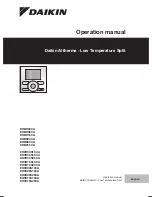
162/226
Building Technologies
Boiler Sequence Controller RMK770
CE1P3132en
HVAC Products
10 Heating circuit control
01.03.2005
10.6.3 Influences on the flow temperature setpoint
Basis for the flow temperature setpoint is the heating curve. In addition, the setpoint is
influenced by the following variables:
•
Room setpoints
•
Actual value room temp
•
Morning boost (refer to subsection 10.8.3 “Quick setback and boost heating”)
The basic heating curve applies to a room temperature setpoint of 20 °C. A positive
room temperature setpoint change
∆
TR corresponds to a heating curve displacement
by the same amount towards the outside temperature and a displacement by the same
amount towards the flow temperature.
31
31
B
21
TFl
TOeff
+
-
SpTR
20 °C
SpTFlDe
SpTFlHi
SpTRN
TFl
TOeff
TODe
TOHi
+
-
+
+
SpTR
Roughly, this corresponds to the value of:
∆
TFl =
∆
TRw × (sHc + 1)
SpTFlDe – SpTFlHi
sHc =
ToHi – ToDe
Setpoint readjustment
∆
TRw = 2 K.
∆
TFl = ?
60 – 30
sHc =
(15– [–5 ])
= 1.5
=>
∆
TFl = 2 K × (1.5 + 1) = 5 K
A deviation of the room temperature from the room temperature setpoint has an impact
on the flow temperature setpoint only if room influence is activated.
Connection of a room temperature sensor does not automatically activate the room
influence.
An LG-Ni 1000 sensor can be connected as a room temperature sensor (extra configu-
ration), or a room unit transmits the room temperature via bus.
In plants where the heating circuit operates in connection with a ventilation system as a
room control combination, the room temperature sensor of the ventilation system must
not be located in the extract air!
The set room influence defines the gain factor with which the room temperature devia-
tion shall be weighted. The heating curve handles this amplified room temperature as a
readjusted room temperature setpoint.
Influence of the room
temperature setpoint
Example
Influence of the room
temperature
⇒
















































